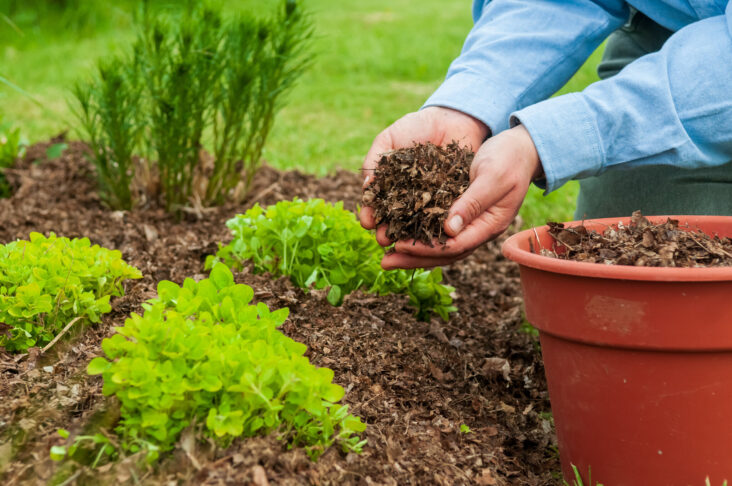Every gardener and homeowner dreads dealing with pesky weeds. These invaders can ruin the look and health of a lawn, rock bed, or garden. Plus, letting weeds get out of hand can be a violation of a city’s code. Residents in an HOA may also face additional fines for violating their bylaws.
Although there are plenty of synthetic and commercial weed killers out there, not every person wants to use them. These chemicals can be harmful to humans, pets, and the environment. But many people don’t know about organic weed control alternatives. Here are some of the best.
1. Vinegar

Vinegar is a natural weed killer most people already have in their cupboards. All it takes is mixing household vinegar solution with water. Put the mixture in a spray bottle and go to town. Household vinegar will work best when it’s sprayed on weeds during a warm, sunny day. The heat will help the vinegar dry out the weeds within a few hours.
Commercial vinegar weed killers also exist for tougher cases. These solutions contain stronger vinegar. Instead of being 5% acidic, store-bought formulas contain up to 20% acetic acid. This high concentration makes these organic weed killers potent. Because of this, it’s important to use gloves and avoid skin contact.
It’s also critical to avoid using vinegar on wet soil. The water from a recent or impending rainstorm will dilute the solution. As a result, the vinegar won’t work. Vinegar is also non-selective, meaning it will dry up grass and other plants. Although grass may turn a white color and grow back, strong enough vinegar solutions can kill the root.
2. Cornmeal
Astute landscapers and gardeners try to get to weeds before they emerge. It’s why pre-emergent chemicals are so popular as spring approaches. Using these chemicals stops seeds from sprouting. But like other forms of synthetic weed control, pre-emergents can harm pets and the environment.
Well, cornmeal can do the same job without the harsh chemicals. The trick is to apply it before weeds start growing. It also helps to apply cornmeal each year to get the best results. The first time it’s applied in the early spring, the results won’t be as good as the following year.
Cornmeal can be put in a spreader to make the job easier. It won’t harm lush green grass, either. A handheld spreader will help spread cornmeal in smaller rock or garden beds. Regular spreaders will cover larger areas like lawns. To learn more about how an organic weed killer works as a natural pre-emergent, visit southlandorganics.com.
3. Salt

Yes, it’s possible to kill weeds with a little table salt. Like vinegar, salt can get rid of weeds by drying them out. It just takes an application of salt around the weed itself. Eventually, the soil will absorb the salt and make the environment less friendly to weed growth.
But like vinegar, too much salt in the soil can also kill off the grass. Diluting salt with water and dish soap is the better way to go. Mix water, dish soap, and a little salt together to make an effective weed killer. By diluting the salt, the surrounding grass will stand a better chance of surviving.
With larger areas, a small spray bottle probably won’t do. Using a larger spray tank can work. Many home improvement websites and stores have them. These sprayers are usually multipurpose, allowing homeowners to fill them with liquid fertilizers and natural weed control solutions.
4. Boiling Water
Boiling water is a weed’s enemy. By pouring boiling water on a weed’s leaves, it will shrink and disappear. The hot water will even reach the root. It’s a good way to kill weeds in a smaller area. However, this method may not be practical for bigger invasions.
That’s because applying boiling water doesn’t get rid of the seeds. So, invasive and noxious weeds can come back within a few weeks. It also takes some effort to boil large amounts of water and carry it outside to the problem areas.
But for those in search of a completely chemical-free solution, boiling water can do the trick. It’s a method that’s also available in a pinch. Buying something from the store isn’t required. All someone needs is a heat source, water from the tap, and a cup.
5. Mulch

Rock beds can add color to a landscape, but weeds can find nearly every gap that exists in them. The rocks also make it harder to pull the weeds out by the root. But creating mulch beds instead can keep the weeds away.
Mulch naturally crowds weeds out and suppresses their growth. To put it mildly, much is not an environment where weeds feel welcome. Mulch can also add color and curb appeal, depending on the type. It’s easy to pick up or order from home improvement stores.
Added benefits of mulch include moisture retention. When placed around trees and shrubs, mulch helps lock in moisture from rainstorms and irrigation. Homeowners don’t have to use as much water in the summer or worry as much about winter watering. It doesn’t take much effort to install mulch beds either. Anyone can do it within minutes.
6. Overseeding
Thick grass is known to crowd out weeds and prevent the seeds from taking hold. This is why overseeding can be a natural form of weed control. Early spring and fall are good times to oversee in northern climates. In warmer areas, overseeding is possible nearly year-long. However, grass seeds have a better chance of growing during times when average temperatures aren’t in the 90s or 100s.
Overseeding isn’t something homeowners with lawns have to do every year. But building thick grass can reduce weeds over time. Overseeding will temporarily consume more water and involve additional lawn care while the seeds are in their growth stages.
Organic weed control is a safer, environmentally-sustainable alternative to synthetic chemicals. Surprisingly, natural weed control methods can be just as effective as synthetic solutions. Some of the techniques, such as overseeding, can reduce the need for chemicals at all. It just takes knowledge and dedication.

